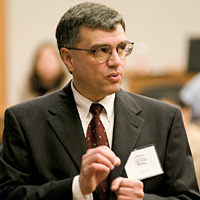| Kellogg
conferences provide opportunity to test student leadership
and marketing
By
Nicole L. Joseph
At Kellogg,
the classroom is one important context in which students acquire
essential management tools.
But a
valuable practical complement to classroom learning is the
experience gained by planning the annual Kellogg School conferences.
Students organize 14 conferences each year, attracting business
leaders from around the world to discuss an array of subjects,
including finance, technology and social entrepreneurship.
| |
 |
| |
© Nathan Mandell
James Dollive, executive vice president and CFO of Kraft
Foods, addresses an audience during the Oct. 27 Finance
Conference, one of more than a dozen annual student-run
confereneces at the Kellogg School. This year's event
focused on "lessons learned" by the markets
in the aftermath of the stock market bubble. |
| |
|
“The
skill you learn most [when working on a conference] is time
management,” says Michael Aingorn ’04, who co-chaired
the speakers committee for the 2004 Private Equity Conference.
“Our leadership team met every week for two hours …
then also had to meet with our committees.”
This
commitment was evident in the conference’s success.
Held in
March, the daylong event featured keynote speakers such as
Prakash Melwani, senior managing director of The Blackstone
Group, and Promod Haque, managing partner of Norwest Venture
Partners.
Aingorn
says the 2004 conference differed from previous efforts by
offering more specificity and practical insights. “The
conference was not just a survey of the industry,” he
says. “Our speakers explained how to get a job in private
equity.”
Chris
Murphy ’04, another organizer of the conference, says
the event transitioned from general education to a “how
to” approach for students interested in private equity
careers.
Aingorn
and Murphy say that organizing the conference was a terrific
way to build leadership and teamwork skills.
“Anytime
you can get leadership experience, it’s a good thing,”
Murphy says. “I think everyone at Kellogg should seek
those opportunities.”
Allison
Barmann ’04 agrees that leadership is one of the main
skills she took away from organizing the Kellogg School Marketing
Conference.
“While
you learn leadership in class, it’s hard to practice
the skills there,” she says. “Running a conference
was a great way to really practice. I learned a lot about
keeping people motivated.”
The two-day
Marketing Conference, held in January, boasted 600 attendees
and a keynote speech by restauranteur Charlie Trotter. Barmann
says that organizing the conference helped her bolster the
very talents the conference promoted.
“You
really improve your marketing skills,” she notes. “You
must decide who this conference is for and exactly what you
are doing.”
Many conferences
follow a set organizational structure. Second-year students
generally serve as the co-chairs, while first-year volunteers
work alongside them to organize speakers and panelists. This
arrangement allows the older students to mentor the new class.
Aingorn
says that while the co-chairs might have more experience,
the first-years bring much to the table too. Even just beginning
a Kellogg career, “you still have a lot of strong business
connections,” says Aingorn. “That’s helpful.”
Conference
organizers spend time seeking speakers and panelists, as well
as corporate sponsors to help make the events possible.
The Asian
Business Conference, held in April, had sponsors such as Johnson
& Johnson, GE Consumer Finance and Microsoft. Each year,
organizers fly in leaders from around the world to discuss
issues pertaining to Asian commerce.
Though
they challenge themselves by adding a significant time commitment
on top of an already-intense academic schedule, conference
organizers feel their efforts are well worth it. Aingorn says
that one of the greatest aspects of the conference is its
team leadership dynamic.
“The
conference gives a lot of people the chance to work together
and get to know each other,” he says. “It’s
a nice bonding experience. We all worked through the challenges
and shared the achievement together.” |



